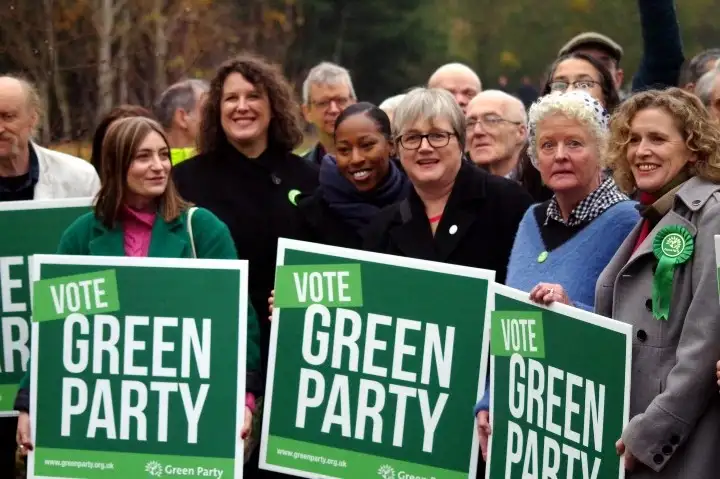The Green Party Manifesto at PolicyFest
Explore the Green Party Manifesto on PolicyEngine.

Contents
The Green Party’s 2019 Manifesto, updated to 2021
Analysis
Green Party campaigners. Credit:
On Monday, I presented a PolicyEngine analysis of the Green Party of England and Wales’ 2019 manifesto at “PolicyFest”, an internal event for Green Party members. Martin Farley, who leads the party’s policy working group, and councillor Martin Osborne also co-presented at the session.
The Green Party’s 2019 Manifesto, updated to 2021#
As he
The manifesto raises revenue from several tax reforms:
-
Abolishes the Personal Allowance, while increasing the higher rate threshold from £37,700 to £50,270
-
Merges National Insurance rates into Income Tax
-
Replaces existing property taxes (Council Tax, Stamp Duty, business rates) with a land value tax (1.2% for households, 1.9% for corporations)
-
Introduces a carbon tax at £135 per tonne
The manifesto also reforms a number of benefits:
-
Repeals Child Benefit, State Pension, and Pension Credit
-
Repeals means-tested benefits except those related to housing, disability, and care, in both the legacy systems and components of Universal Credit
-
Reduces the taper rate of Universal Credit from 55% to 40%
-
Introduces a universal basic income of £75 per week for children, £94 per week for working-age adults, and £185 per week for pension-age adults
-
Introduces a “single pensioner supplement” of £25 per week to pensioners living alone, reduced at a rate of 10% with non-benefit income
All of the above parameters are available now on PolicyEngine for anyone to use, including the newly-added Single pensioner supplement under the Green Party section.
Analysis#
PolicyEngine finds that implementing the manifesto would produce a net £15.8bn deficit, while reducing poverty by a third and leaving 67% of the population better off.
The manifesto would cut poverty similarly across age groups, though a bit more for children and seniors. The 33 percent overall reduction equals the poverty reduction seen in the 17-year period from 2003 to 2020.

The manifesto produces a progressive distributional impact, with all income deciles outside the highest decile coming out (in aggregate) ahead. It reduces the Gini index of income inequality by 7.2% and the top 1 percent’s income share by 3.3%.

This doesn’t mean all households within those deciles come out ahead: at least 10% of each decile come out behind, though 51% would see their income rise by at least 5%.

Several factors explain the manifesto’s heterogeneous effects by income decile: some households receive larger welfare benefits under the existing system than the UBI; high-asset households would owe substantial land value tax; high-consumption households would owe substantial carbon taxes; and so on. To the extent that wealth and consumption diverge from income, these taxes may affect some low-income households, as we assume that all taxes are paid immediately.
The manifesto policy reduces the number of tax parameters and makes the tax code more monotonically progressive. Under the current system, most families with children and no housing costs face marginal tax rates above 50% in three earnings regions: the Universal Credit phase-out, the Child Benefit High-Income Tax Charge, and the Personal Allowance reduction. The Green Party manifesto policy eliminates all three, resulting in a progressive marginal tax schedule with only three rates (32%, 42%, and 47%). Families with housing costs or other qualifications for remaining means-tested benefits will continue to have high marginal tax rates in some earnings regions.

*Marginal tax rates for a two-child, single-parent household with *£30,000 income and no housing costs
Overall, we find that the Green Party manifesto reduces poverty and inequality, benefits the majority of the population, simplifies tax and benefit rules, and reduces marginal tax rates on earnings, especially for low-income households. However, it produces a £15.8 billion deficit on a static basis. See the results in more detail, as well as a customizable household calculator and the option to reform the manifesto,
Updated on 2022–02–04 to reflect PolicyEngine’s new accuracy-enhancing survey weights, and to increase the higher rate threshold from £37,700 to £50,270 following discussions with the Green Party.

nikhil woodruff
PolicyEngine's Co-founder and CTO

Subscribe to PolicyEngine
Get the latests posts delivered right to your inbox.
PolicyEngine is a registered charity with the Charity Commission of England and Wales (no. 1210532) and as a private company limited by guarantee with Companies House (no. 15023806).
© 2025 PolicyEngine. All rights reserved.